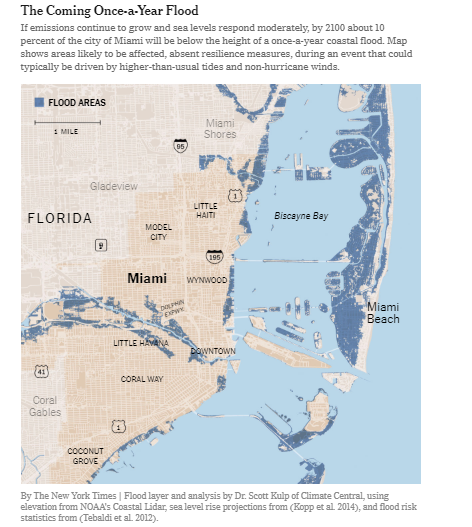Miami Battles Rising Seas
In 2017, voters agreed to finance adaptation efforts through property taxes. Now the first phase of those projects is underway.
By Ban Ki-moon and Francis Suarez

Homes in North Miami, Fla., were damaged by floodwater from Hurricane Irma in 2017.CreditCreditKevin Hagen for The New York Times
Climate change is not a distant threat for Miami; it’s a daily presence in people’s lives. The city has been fighting to stay above water for decades. It knows that its future as a vibrant international hub for business, tourism, arts and culture depends on making the city more resilient to the impact of global warming.
That’s why the city of Miami is moving aggressively to adapt; in 2017, its citizens voted to tax themselves to build resilience against flooding and storm surges by approving a $400 million bond issue that is financing projects across the city.
Miami is not alone, of course, in facing these threats. Around the globe, some 800 million people in hundreds of coastal cities are at risk from storm surges and rising seas. We want to share what we have learned in building resilience against the changing climate.
One reality we have come to understand is this: Our current efforts to protect coastal cities will fall short of what will be required in decades to come. For in spite of global efforts to rein in carbon dioxide emissions that cause global warming, they continue to rise and expose coastal cities like Miami to more extreme weather events and rising seas. And yet, the world’s biggest economies invested only about $25 billion on adaptation overall in 2014, despite losing many times that amount to floods, storms, wildfires and droughts. Clearly, more investment is needed to build resilience, especially to protect the world’s coastal regions and cities.
We have also learned that there is strength in numbers. Miami can access a wealth of resources, including sea level rise projections, thanks to its membership in regional bodies like the Southeast Florida Regional Climate Change Compact. The city has also gained a broader perspective on urban resilience challenges and approaches by joining global networks such as the Global Commission on Climate Adaptation, where we both serve as board members, and 100 Resilient Cities.
Finally, we have learned that effective adaptation is a collective endeavor. It requires a holistic, long-term approach that takes into account the needs of our citizens today and in the future. This requires robust and meticulous long-term planning, informed investment in resilient infrastructure, adapting land use and building policies to address the climate challenge, advancing new transportation solutions, educating and informing citizens about climate change, training and mobilizing volunteers during emergencies, informing private property owners of climate risks, and forging partnerships with research institutions and business innovators. As this long list makes clear, there isn’t a single aspect of our daily lives that isn’t affected by climate change.
Perhaps one of the reasons there is so little investment in adaptation is the lack of financial incentives. Unlike a wind farm, for example, that can earn a steady return for investors, the monetary benefits of adaptation are less straightforward. Investing in resilience protects businesses and communities from devastating losses, so it must be measured in the lives saved and businesses that remain open. We are only now learning how to quantify these benefits to communities. Florida’s Division of Emergency Management, for example, calculated that projects to reduce wind and water damage avoided $81 million in losses when Hurricane Matthew struck in 2016, while costing only $19 million to carry out. The projects included raising buildings, improving drainage, and buying and demolishing properties in vulnerable areas.
That is why leadership, particularly from city governments like Miami’s, is so important in driving investment in adaptation. After Hurricane Irma in September 2017 — one of the costliest in United States history, leaving a $50 billion trail of destruction — there was both a moral and a fiscal obligation to act. That’s why two months later, Miami voters approved the $400 million Miami Forever Bond.
The program is the city’s answer to the shortfall of investment in adaptation. It brings together city planners, private sector innovators and citizens to build a stronger, more resilient future for Miami. Almost half this amount is being invested in flood defenses and other measures to combat the effects of rising sea levels. The remaining funds will be invested in affordable housing, tree planting, road work and an innovative approach to urban landscape design that will allow residents to continue enjoying waterfront access while improving drainage and sea wall defenses.
On Tuesday, we had the opportunity to visit resilience projects financed by the bond in the heart of Miami’s Brickell financial district. They include expanding drainage capacity to reduce flooding and new pumping stations to collect storm water runoff and discharge it into the Miami River and Biscayne Bay. In addition, a project along Brickell Bay Drive will raise the elevation of nearly one and a half miles of sea wall on Biscayne Bay to prevent flooding from storm surges, and a redesign of Jose Marti Park along the Miami River will reduce flood risk.
We hope that along with these projects, Miami’s resilience bond will become a catalyst for greater private sector investment and innovation in climate adaptation. We also hope it will spur similar initiatives in coastal cities around the globe.
Ban Ki-moon, a former secretary general of the United Nations, is a co-chairman of the Global Commission on Adaptation. Francis Suarez is the mayor of Miami.

0 comments:
Publicar un comentario